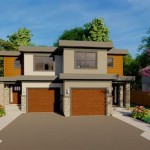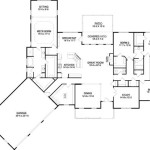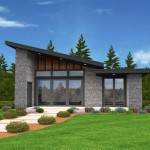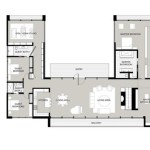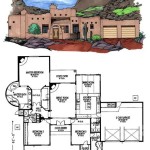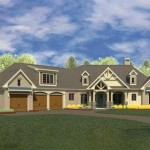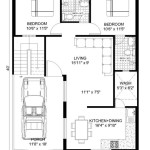5 Bedroom House Floor Plan Design: Maximizing Space and Functionality
Designing a 5-bedroom house floor plan requires a significant investment of time and planning to ensure that the resulting structure meets the needs of a growing family, accommodates guests, or provides space for specific activities and hobbies. The key is to balance the desire for ample individual space with the necessity of creating functional and inviting common areas. This article explores the considerations and design principles involved in creating effective 5-bedroom house floor plans, focusing on maximizing space utilization, optimizing flow, and addressing practical requirements.
The first step in the process involves a careful assessment of the occupants' needs and lifestyle. This assessment should consider the number of individuals who will reside in the house, their ages, any specific requirements such as accessibility needs, and the types of activities that will take place within the home. For instance, a family with young children will require different design considerations than a family with teenagers or a household with multiple adults working from home. A detailed understanding of these requirements will inform the layout, room sizes, and the placement of different zones within the house.
Budgetary constraints and lot size also play a crucial role in determining the feasibility of different design options. Larger house plans will naturally require a larger budget due to the increased material and labor costs. Lot size will limit the overall footprint of the house, impacting the possibility of sprawling single-story designs versus more compact multi-story layouts. Examining local building codes and zoning regulations is also essential to ensure that the proposed design complies with all applicable requirements.
Key Point 1: Zone Planning and Spatial Organization
Effective 5-bedroom house floor plans are often organized into distinct zones, each catering to specific functions and activities. These zones typically include a living/social zone, a sleeping/private zone, a service zone, and potentially, a recreational zone. The living/social zone encompasses areas such as the living room, dining room, and kitchen, designed for interaction and entertainment. The sleeping/private zone includes the bedrooms and bathrooms, providing a quiet and restful environment. The service zone includes the laundry room, mudroom, and garage, facilitating practical tasks and storage. The recreational zone may include a home office, gym, or media room, catering to specific hobbies and interests.
The placement and interaction between these zones are crucial for overall functionality. For example, the kitchen should be conveniently located near the dining room for ease of serving meals. The bedrooms should be located away from high-traffic areas to minimize noise and disturbance. A clear and logical flow between these zones is essential to create a comfortable and efficient living environment.
Considerations for zone planning also involve soundproofing and privacy. Bedrooms should ideally be located away from the living room and kitchen to minimize noise transfer. Bathrooms should be easily accessible from the bedrooms but also accessible to guests without compromising privacy. Strategically placed hallways and doorways can also help to buffer sound and create a sense of separation between different zones.
The design of the main entry is also crucial in defining the initial experience of the house. A welcoming foyer that provides a clear transition between the exterior and interior spaces creates a positive first impression. The foyer should ideally provide access to the living areas, but also offer a visual separation from the more private areas of the house.
Key Point 2: Optimizing Bedroom Layout and Functionality
Given that the house design includes five bedrooms, careful attention must be paid to the layout and functionality of each room. Bedroom sizes should be adequate to comfortably accommodate the intended occupants and their activities. Master bedrooms typically require more space than secondary bedrooms to accommodate a larger bed, seating area, and ensuite bathroom. Secondary bedrooms should still provide sufficient space for a bed, desk, and storage.
Closet space is a critical consideration in bedroom design. Adequate closet space is essential for storing clothing and personal belongings, minimizing clutter and maintaining a tidy living environment. Walk-in closets are often preferred in master bedrooms, while secondary bedrooms may utilize reach-in closets or built-in storage solutions. Consider incorporating shelving, drawers, and hanging rods within the closets to maximize organization.
Natural light is another important factor in bedroom design. Windows should be strategically placed to provide ample daylight without compromising privacy. Consider the orientation of the house and the position of the sun when determining window placement. Skylights can also be used to bring natural light into bedrooms, particularly in areas where traditional windows are not feasible.
The inclusion of ensuite bathrooms in master bedrooms is a common design feature, providing privacy and convenience for the occupants. Ensuite bathrooms typically include a toilet, sink, and shower or bathtub. The layout of the ensuite bathroom should be carefully considered to maximize space and functionality. Secondary bedrooms may share a common bathroom, or each may have access to a separate bathroom depending on the overall design and budget.
Flexible use of bedrooms is often incorporated to adapt to changing needs. A bedroom can be adaptable as a guest room, home office or hobby room. Consider including features that allow for easy conversion, such as built-in shelving, ample electrical outlets, and adjustable lighting.
Key Point 3: Circulation and Flow
The circulation and flow within a 5-bedroom house floor plan are essential for creating a comfortable and functional living environment. Corridors should be wide enough to accommodate traffic and furniture movement. Avoid long, narrow corridors that can feel claustrophobic. Consider using open floor plans to minimize the need for corridors and create a sense of spaciousness.
The placement of staircases is crucial for the functionality of multi-story houses. Staircases should be easily accessible from the main living areas and should be designed to be safe and comfortable to use. Consider the impact of the staircase design on the overall aesthetic of the house. Staircases can be a focal point in the design, or they can be tucked away in a less prominent location.
Consider the flow between indoor and outdoor spaces. Patios, decks, and balconies can extend the living space and provide opportunities for outdoor recreation and relaxation. Doors leading to these outdoor spaces should be strategically placed to maximize usability and convenience. Consider incorporating features such as covered porches or pergolas to provide shade and protection from the elements.
Accessibility considerations are also important, especially in housing that is designed to accommodate aging in place. Wider doorways, ramps, and grab bars in bathrooms can make the house more accessible to individuals with mobility limitations. Consider these accessibility features during the design phase to ensure that the house is functional and comfortable for all occupants.
The placement of utilities, such as the laundry room and water heater, should also be carefully considered. These utilities should be located in areas that are easily accessible but do not disrupt the flow of the house. Consider incorporating soundproofing measures in the laundry room to minimize noise transfer to other areas of the house.
The design of a 5-bedroom house floor plan requires a comprehensive understanding of the occupants' needs, budgetary constraints, and site conditions. By carefully considering zone planning, bedroom layout, and circulation, it is possible to create a functional and comfortable living environment that meets the unique requirements of a diverse range of households. It will enhance the homeowners wellbeing and improve the quality of life.

European Style House Plan 5 Beds 3 Baths 2349 Sq Ft 36 442

Room To Grow 5 Bedroom House Plans Houseplans Blog Com

5 Bedroom Bungalow Rf 5001

House Design Plan 16 5x10m With 5 Bedrooms Home Ideas C5e

5 Bedroom Home With Double Garage

5 Bedroom Single Y House Plan For 363sqm Nethouseplans

5 Bedroom Modern House Plan For Designs Plandeluxe

5 Bedroom Modern House Plan 5165 Sq Ft 116 1106

Bernardino 5 Bedroom House Plan Php 2024025 2s Pinoy Plans

N 5 Bed House Plans 260 4 M2 Or 2800 Sq Feet Bedroom Design Floor Blueprints Home

